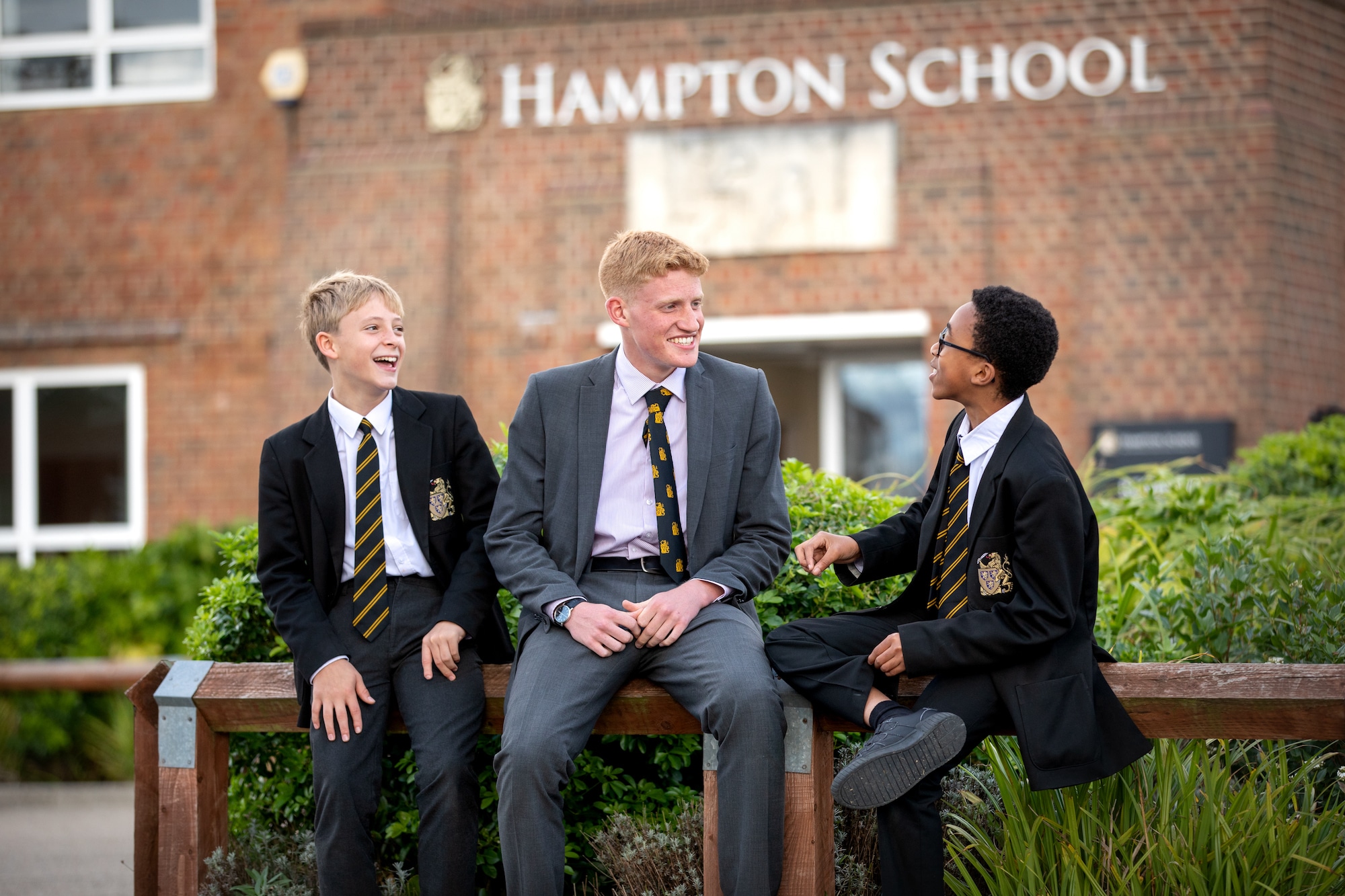INTERACTIVE SCHOOL MAP
1
The new Hampton School
In September 1939 Hampton School moved from a previous site to the current location in Hanworth Road. The outbreak of War in September 1939 disrupted the moving in and no formal opening ceremony took place. All the accounts bear testament to the positive spirit of Hamptonians during those first fearful months of the Second World War.
From the Lion Magazine Autumn 1939/Spring 1939-1940:
The building is almost ideally planned and beautifully finished. The war has not robbed us of much- as yet at any rate – and we are profoundly thankful that the building has not been commandeered, even in part.
2
The Tower
During the War the Tower afforded boys a place to spot enemy planes. It might be surprising to know that any senior boy at Hampton was allowed to become a fire-watch Air Raid Precaution Warden if he had the permission of his parents! Senior boys joined alongside staff and Old Hamptonians to carry out this duty.
Peter Hornsby’s diary records:
Monday, 26 August, 1940 – Raid at 12.30…… I saw a wonderful sight- the Nazi plane was dropping parachute flares…….they lit up the whole district for the about 5 or 10 minutes.
Ken Rice, Hampton Grammar School in Wartime 1939-1945 (Published 2009)
3
Air Raid Shelters
The War necessitated the speedy construction of onsite air-raid shelters. The building began in November 1939 but it was not without some disruption. The Headmaster’s secretary explained clearly how the outside of the new School was altered in its appearance.
The grounds in front, which should have been sweeping lawns and flower beds, now took on another aspect – deep trenches were dug, reinforced and roofed – very grim indeed!
The outside air raid shelters could hold 375 boys and staff whilst another 850 could be sheltered inside.
The boys and staff at Hampton School escaped any bombs falling directly on the School site, the closest bombs falling further to the east end of Hanworth Road.
4
Allotments
The ‘Dig for Victory’ campaign was established in 1941 by the British Ministry of Agriculture.
During the Easter holidays of 1941, boys at Hampton began ‘Digging for Victory’ in the school garden. This was expanded to the opposite side of the main drive.
By July of 1942 there were 50 allotment plots outside the front of the School. The Lion magazine provided an update in the Autumn 1942 edition.
It is very pleasing to notice that the allotments are still flourishing. In fact the demands are greater than can be met, since the entire front of the School, by the shelters, has now been dug up.

5
Anti Aircraft Trenches
The School playing field was a significant feature of the new site. During the War however it was not possible to use them for playing sports.
The Battle of Britain brought fear of possible German invasion. The Royal Engineers were tasked with digging trenches and cutting up the field to prevent the possibility of enemy aircraft being able to land on such a vast area of land.
Loss of the School games’ facilities was made inevitable by arranging for the Royal Engineers to cut up more of the school field ‘so it cannot be used by enemy aircraft.’
Ken Rice, Hampton Grammar School in Wartime 1939-1945 (Published 2009)
6
Pig Club
In 1942 boys at Hampton School established their own Pig Club.
The Lion explained the basic rules of pig keeping:
Of each pair of pigs killed, one is sold to the Ministry of Food and the other is shared among the members. The waste food from the School kitchen is used for pig food after being boiled.
On Christmas Day 1942, the pigs escaped the sty after a boy had left the sty unlatched. The pigs wandered out into Hanworth Road, turned into Nightingale Lane and ended up 750m away in Wensleydale Road. They were found in someone’s garden looking for food and boys had to spend their Christmas Day afternoon guiding them back to the School’s sty!
7
Rifle Range
The Rifle Club was first established in 1938. In the summer term, members aimed to meet every Tuesday and Friday evening as daylight hours provided enough time to shoot after lessons. During autumn and winter months, evening meetings were difficult, so they met on Thursday afternoons instead. However, with the rifle range being outside, adverse weather often hampered pupils’ shooting, with many reports in The Lion commenting how ‘rain stopped play’.
The pupils took part in shooting competitions with other rifle clubs. For example, Hampton School often competed against Sunbury Rifle Club. These competitions saw the winning team (of 3 or 6 pupils, depending on the particular competition) take home 5 shillings – around £9 in today’s money. The rifles used were bolt action as the 1937 Firearms Act banned most fully automatic weapons.
To the delight of the pupils, in 1945 the Rifle Club acquired a new shooting range, which adjoined the Hampton Swimming Baths. Pupils loved the fact it was undercover and that it took only five minutes to get there; an important consideration for the pupils who weren’t fond of having to lug their rifles and telescopes too far. Plus, the pupils were very relieved not to have to bother the headmaster’s secretary for yet more drawing pins to pin up their targets!
8
Training Corps
Hampton School’s Air Training Corps – named Flight 651 – was officially established on 1 February 1941. Boys who joined were trained in preparation for joining the Royal Air Force. This training was extremely demanding, not least because it took place after a normal day’s work at School.
In Autumn 1941, boys received a visit from Air-Commodore Sir John Adrian Chamier ‘the founding father of the ATC’. Wishing to impress, The Lion explains how boys ‘brushed up’ on drill for the occasion and took the parade ground with ‘all strength of lung and larynx’. Hampton boys were also awarded ‘best in parade’ out of 700 attendees at a national training camp held at RAF Halton.
By the following year, 180 cadets and airmen had received training in the Unit.
9
War Memorial
Hampton School’s contribution to World War Two was significant and with that came loss of life. In total over 1,000 former Hamptonians served in the armed forces. The 118 that died are commemorated on the School’s Honours Board and War Memorial.
The contribution of Old Hamptonians to the war effort was also publicly recognised: 40 decorations were awarded in the years following, including 17 Distinguished Flying Crosses, five Military Crosses, two Distinguished Service Order medals and a CBE.
In the same Main Hall where boys have assembled since 1939, Hampton School holds an annual remembrance assembly to commemorate those who have served their country in wartime.






